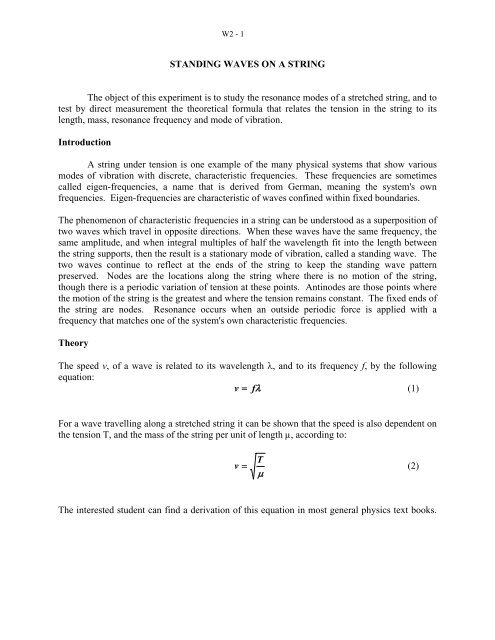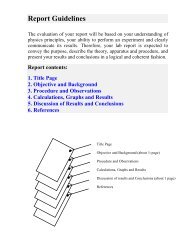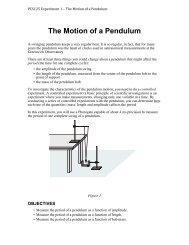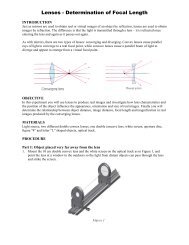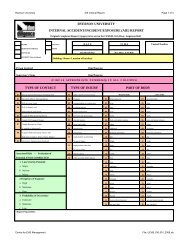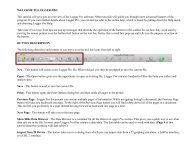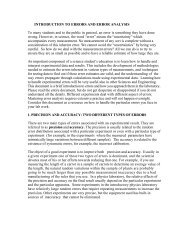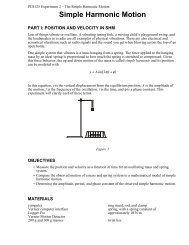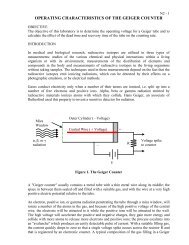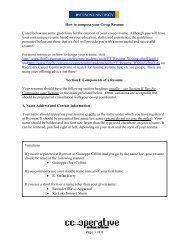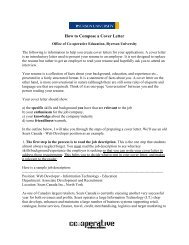Standing Waves on a String - Ryerson Department of Physics
Standing Waves on a String - Ryerson Department of Physics
Standing Waves on a String - Ryerson Department of Physics
Create successful ePaper yourself
Turn your PDF publications into a flip-book with our unique Google optimized e-Paper software.
W2 - 1<br />
STANDING WAVES ON A STRING<br />
The object <strong>of</strong> this experiment is to study the res<strong>on</strong>ance modes <strong>of</strong> a stretched string, and to<br />
test by direct measurement the theoretical formula that relates the tensi<strong>on</strong> in the string to its<br />
length, mass, res<strong>on</strong>ance frequency and mode <strong>of</strong> vibrati<strong>on</strong>.<br />
Introducti<strong>on</strong><br />
A string under tensi<strong>on</strong> is <strong>on</strong>e example <strong>of</strong> the many physical systems that show various<br />
modes <strong>of</strong> vibrati<strong>on</strong> with discrete, characteristic frequencies. These frequencies are sometimes<br />
called eigen-frequencies, a name that is derived from German, meaning the system's own<br />
frequencies. Eigen-frequencies are characteristic <strong>of</strong> waves c<strong>on</strong>fined within fixed boundaries.<br />
The phenomen<strong>on</strong> <strong>of</strong> characteristic frequencies in a string can be understood as a superpositi<strong>on</strong> <strong>of</strong><br />
two waves which travel in opposite directi<strong>on</strong>s. When these waves have the same frequency, the<br />
same amplitude, and when integral multiples <strong>of</strong> half the wavelength fit into the length between<br />
the string supports, then the result is a stati<strong>on</strong>ary mode <strong>of</strong> vibrati<strong>on</strong>, called a standing wave. The<br />
two waves c<strong>on</strong>tinue to reflect at the ends <strong>of</strong> the string to keep the standing wave pattern<br />
preserved. Nodes are the locati<strong>on</strong>s al<strong>on</strong>g the string where there is no moti<strong>on</strong> <strong>of</strong> the string,<br />
though there is a periodic variati<strong>on</strong> <strong>of</strong> tensi<strong>on</strong> at these points. Antinodes are those points where<br />
the moti<strong>on</strong> <strong>of</strong> the string is the greatest and where the tensi<strong>on</strong> remains c<strong>on</strong>stant. The fixed ends <strong>of</strong><br />
the string are nodes. Res<strong>on</strong>ance occurs when an outside periodic force is applied with a<br />
frequency that matches <strong>on</strong>e <strong>of</strong> the system's own characteristic frequencies.<br />
Theory<br />
The speed v, <strong>of</strong> a wave is related to its wavelength λ, and to its frequency f, by the following<br />
equati<strong>on</strong>:<br />
v = fλ<br />
(1)<br />
For a wave travelling al<strong>on</strong>g a stretched string it can be shown that the speed is also dependent <strong>on</strong><br />
the tensi<strong>on</strong> T, and the mass <strong>of</strong> the string per unit <strong>of</strong> length µ, according to:<br />
T<br />
v = (2)<br />
μ<br />
The interested student can find a derivati<strong>on</strong> <strong>of</strong> this equati<strong>on</strong> in most general physics text books.
W2 - 2<br />
Combining equati<strong>on</strong>s (1) and (2) results in the following equati<strong>on</strong> that will be c<strong>on</strong>venient for this<br />
experiment:<br />
1 T<br />
f = (3)<br />
λ μ<br />
For standing waves the distance L, between the fixed supports <strong>of</strong> the string is an integer multiple<br />
<strong>of</strong> half the wavelength:<br />
λ<br />
L = n<br />
(4)<br />
2<br />
For the basic or fundamental mode <strong>of</strong> vibrati<strong>on</strong> n = 1, so λ = 2L. For the sec<strong>on</strong>d mode also<br />
called the sec<strong>on</strong>d harm<strong>on</strong>ic n = 2, λ = L. For the third mode or the third harm<strong>on</strong>ic n = 3, et<br />
cetera. These modes <strong>of</strong> vibrati<strong>on</strong> are shown in the Figure 1 below:<br />
n = 1<br />
n = 2<br />
n = 3<br />
Figure 1. Modes <strong>of</strong> vibrati<strong>on</strong> in a string<br />
Combining equati<strong>on</strong>s (1), (2) and (3), we obtain an equati<strong>on</strong> for the res<strong>on</strong>ant frequencies f n :<br />
n T<br />
1<br />
f n<br />
= or f n<br />
= n T<br />
(5)<br />
2L μ<br />
2L μ<br />
This is the equati<strong>on</strong> <strong>of</strong> a straight line, y = mx + b . If we let y = fn<br />
and x = n T , then the<br />
resulting line should have a slope <strong>of</strong> :<br />
1<br />
slope = (6)<br />
2L μ
W2 - 3<br />
The parameters <strong>of</strong> the system in this case are the Tensi<strong>on</strong> (T), the Length (L) and the mass per<br />
unit length (μ) <strong>of</strong> the string. If we fix the values <strong>of</strong> any two the third can be measured. The<br />
easiest to fix are T and L and use a measurement <strong>of</strong> f n to determine μ.<br />
Procedure<br />
Pulley<br />
Bridge<br />
L<br />
<strong>String</strong><br />
Rigid<br />
Support<br />
Weight<br />
Variable<br />
Frequency<br />
Vibrator<br />
Figure 2. <str<strong>on</strong>g>Standing</str<strong>on</strong>g> waves apparatus<br />
1. Set up the apparatus as shown in the Figure 2 above. Slide the wooden bridge under the<br />
string to adjust the porti<strong>on</strong> <strong>of</strong> the string that can be set into res<strong>on</strong>ance by the vibrator to be<br />
between 1 and 1.5 metres. Measure the length carefully. Set the tensi<strong>on</strong> (T = Mg) by<br />
making the suspended mass M =100g.<br />
2. Adjust the frequency <strong>of</strong> the vibrator to get a standing wave pattern with n = 1 and record<br />
the value <strong>of</strong> the frequency. Increase the frequency until a standing wave with 2 loops is<br />
obtained. Repeat to a maximum frequency <strong>of</strong> about 350Hz. The wavelength for each<br />
standing wave pattern may be found from the equati<strong>on</strong> λ = 2L/n.<br />
3. Increase the mass <strong>on</strong> the string to 200g and repeat steps 1 and 2 above. Do this again for<br />
300g. In each case the tensi<strong>on</strong> in the string will be the mass times g (9.8 m/s 2 ).
W2 - 4<br />
Analysis<br />
1. For each combinati<strong>on</strong> <strong>of</strong> f, n and T a value <strong>of</strong> μ can be obtained and these could simply be<br />
averaged. Alternatively <strong>on</strong>e could group the observati<strong>on</strong>s and for each value <strong>of</strong> T plot the<br />
values <strong>of</strong> f vs. n T and then use the slope to find μ, as suggested by equati<strong>on</strong> (6):<br />
n<br />
μ =<br />
1<br />
( 2L ⋅ slope) 2<br />
2. Although this value is small, a measure can be obtained by direct weighing <strong>of</strong> a sample <strong>of</strong><br />
string using the electr<strong>on</strong>ic balance in the lab. You will now try to measure μ directly and<br />
compare this value to what you obtained through experiment. Measure a length <strong>of</strong> string<br />
about 2 – 3 metres l<strong>on</strong>g. You may use the same string you did the experiment with, or a<br />
new length <strong>of</strong> string. Weigh this string <strong>on</strong> the electr<strong>on</strong>ic balance, and calculate the value<br />
for μ.<br />
3. Compare the value for μ obtained by each method. Analyse the sources <strong>of</strong> uncertainty for<br />
each measurement and comment <strong>on</strong> the relative accuracy <strong>of</strong> the values obtained by direct<br />
and indirect measurement.


